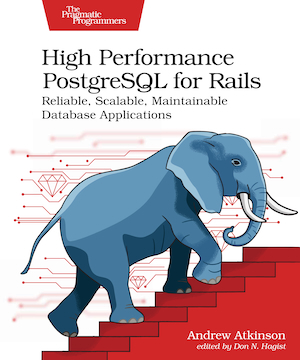By using UNLOGGED tables, we can insert rows at a higher rate when compared with a logged table (the default). But there’s a trade-off.
Activity for regular logged tables receives all changes from the Write-Ahead Log (WAL). UNLOGGED tables do not use the WAL, which means there is the possibility of data loss for these tables if PostgreSQL unexpectedly restarts.
The post How to test UNLOGGED tables for performance in PostgreSQL shows how an UNLOGGED table can be truncated during a shut down.
Using an Unlogged table for primary data that’s not stored elsewhere, is not recommended. However, for secondary data that can be re-created, crash protection is worth losing because of the improved write speed.
What does that look like?
RETURNING Clause
Before jumping into that, let’s look at the RETURNING clause, to put together an example with an unlogged table.
The RETURNING clause returns an explicit list of field data following an Insert, Update, or Delete, or all fields using RETURNING *.
Let’s test this out. You’ll explore the UNLOGGED keyword, RETURNING * clause, and populate 10 million rows into a table.
Create a table called tbl that has a single integer column, then use the GENERATE_SERIES() function to help populate values.
Run the SQL below to load a regular logged table with 10 million items. You should see it taking around 10 seconds (tested on a M1 Macbook Air).
\timing -- toggle timing so that it's enabled
CREATE SCHEMA IF NOT EXISTS temp;
CREATE TABLE IF NOT EXISTS temp.tbl (col INTEGER);
INSERT INTO temp.tbl (col) VALUES (GENERATE_SERIES(1,10000000));
What about Unlogged tables?
Try dropping the current table, creating a new one as unlogged, and performing the same load of 10 million items.
DROP TABLE temp.tbl;
CREATE UNLOGGED TABLE temp.tbl (col INTEGER);
INSERT INTO temp.tbl (col) VALUES (GENERATE_SERIES(1,10000000));
This ran considerably faster, completing in under 2 seconds.
Inserting In Bulk
We know that inserting multiple rows at once is faster compared with single row Inserts, because there isn’t a transaction per insert.
Using these techniques, we could design a system to store rows in an UNLOGGED table as a staging area, then move them to a logged table as bulk Insert statements at some point later.
To avoid the rows being in two places at once, we’ll delete them from the UNLOGGED table and use RETURNING * to gather all the field data, then insert that field data as new rows effectively moving a row from one table to the other.
This is a “transactional copy” since the statement runs as an implicit transaction, and if it failed, the row would only be in one table.
Try running the following statements:
-- Use existing temp.tbl loaded with 10 million rows
-- Create normal logged table
CREATE TABLE IF NOT EXISTS temp.logged_tbl (col INTEGER);
-- Copy the rows over
WITH deleted AS (
DELETE from temp.tbl
RETURNING *
)
INSERT INTO temp.logged_tbl (col)
SELECT * FROM deleted;
-- temp.logged_tbl should now have all 10 million rows,
-- and temp.tbl should be empty
The statement moves all 10 million rows from the UNLOGGED table to the logged table in a single statement, taking around 15 seconds.
This could be done in batches of rows at a time by using ranges of values, or a LIMIT clause.
The purpose here was to show the basics of performing higher speed copies or moves of data between tables.
Summary
In this post we covered UNLOGGED tables, the RETURNING clause, and how to use a transactional copying bulk insert operation.

